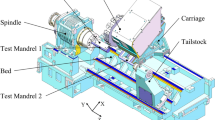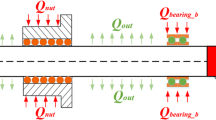Abstract
The axial thermal errors of CNC lathes are mostly caused by the thermal deformation of the screw and spindle. It is necessary to establish a prediction model to evaluate the thermal error distribution of CNC lathes. First, a new real-time virtual frictional heat model under the time-varying working speed of various kinematic pairs in the screw and spindle systems was proposed using the real-time torque current. Furthermore, a novel one-dimension lumped capacity method, which can be used to determine the temperature field rapidly, was proposed, considering the sensitiveness of the temperature of the measuring point with the heat generation rate. By an inverse FEM thermal-solid method of screw and spindle systems, the friction heat distribution and sensitiveness of the temperature of the measuring point with the heat generation rate were obtained. Consequently, based on the one-dimension lumped capacity method, the real-time thermal error prediction model was established, which is used to predict the temperatures and axial thermal errors of the screw and spindle of the machine tools. From the FANUC digit control system, the servomotor torque currents of the screw and spindle and the position of the moving-nut were read and used as inputs by the FOCAS library function. The effectiveness of the proposed prediction model of thermal errors is verified through the experimental and FEM results. This method uses the servomotor torque current collected by the FOCAS library function to determine the heat boundary condition. It can quickly and accurately determine the thermal errors without requiring additional temperature sensors.








Similar content being viewed by others
References
Liu K, Li T, Wang Y, Sun M, Wu Y, Zhu T (2018) Physically based modeling method for comprehensive thermally induced errors of CNC machining centers. Int J Adv Manuf Technol 94:463–474. https://doi.org/10.1007/s00170-017-0736-9
Ramesh R, Mannan MA, Poo AN (2003) Thermal error measurement and modeling in machine tools. Part I: Influence of varying operation condition. Int J Mach Tools Manuf 43:391–404. https://doi.org/10.1016/S0890-6955(02)00263-8
Liu K, Sun M, Zhu T, Wu Y, Liu Y (2016) Modeling and compensation for spindle's radial thermal drift error on a vertical machining center. Int J Mach Tools Manuf 105:58–67. https://doi.org/10.1016/j.ijmachtools.2016.03.006
Li T, Yuan J, Zhang Y, Zhao C (2020) Time-varying reliability prediction modeling of positioning accuracy influenced by frictional heat of ball-screw systems for CNC machine tools. Precis Eng 64:147–156. https://doi.org/10.1016/j.precisioneng.2020.04.002
Mayr J, Jedrzejesjewski J, Uhlmann E (2012) Thermal issues in machine Tools. CIRP Ann-Manuf Techn 61:771–793. https://doi.org/10.1016/j.cirp.2012.05.008
Liu K, Liu Y, Sun M, Li X, Wu Y (2016) Spindle axial thermal growth modeling and compensation on CNC turning machines. Int J Adv Manuf Technol 87:2285–2292. https://doi.org/10.1007/s00170-016-8593-5
Schwenke H, Knapp W, Haitjema H, Weckenmann A, Schmitt R, Delbressine F (2008) Geometric error measurement and compensation of machines — an update. CRIP Ann Manuf Techn 57(2):660–675. https://doi.org/10.1016/j.cirp.2008.09.008
Tanabe I, Takada K (1994) Thermal deformation of machine tool structures using resin concrete. Jpn Soc Mech Engrs C 37(2):384–389
Moriwaki T (1988) Thermal deformation and its on-line compensation of hydrostatically supported precision spindle. CIRP Ann-Manuf Techn 37(1):393–396. https://doi.org/10.1016/S0007-8506(07)61662-X
Babu SR, Raja VP, Thyla PR, Thirumalaimuthukumaran MM (2014) Prediction of transient thermo-mechanical behavior of the headstock assembly of a CNC lathe. Int J Adv Manuf Technol 74:17–24. https://doi.org/10.1007/s00170-014-5916-2
Venugopal R, Barash M (1986) Thermal effects on the accuracy of numerically controlled machine tools. CRIP Ann Manuf Techn 35(1):255–258
Week M, Zangs L (1975) Computing the thermal behavior of machine tools using the finite element method-possibilities and limitations. Proc 16th MTDR Conf 16:185–194
Liu Y, Wang XF, Zhu XG, Zhai Y (2021) Thermal error prediction of motorized spindle for five-axis machining center based on analytical modeling and BP neural network. J Mech Sci Technol 35(1):281–292. https://doi.org/10.1007/s12206-020-1228-7
Zhang Y, Yang JG, Jiang H (2012) Machine tool thermal error modeling and prediction by grey neural network. Int J Adv Manuf Technol 59:1065–1072. https://doi.org/10.1007/s00170-011-3564-3
Shi H, Jiang CP, Yan ZZ, Tao T, Mei XS (2020) Bayesian neural network-based thermal error modeling of feed drive system of CNC machine tool. Int J Adv Manuf Technol 108(9-10):3031–3044. https://doi.org/10.1007/s00170-020-05541-1
Yang HJ, Xing RP, Du FX (2020) Thermal error modelling for a high-precision feed system in varying conditions based on an improved Elman network. Int J Adv Manuf Technol 106(1-2):279–288. https://doi.org/10.1007/s00170-019-04605-1
Li GL, Ke H, Li CZ, Li B (2020) Thermal error modeling of feed axis in machine tools using particle swarm optimization-based generalized regression neural network. J Comput Inf Sci Eng 20(2):1–13. https://doi.org/10.1115/1.4045292
Jin C, Wu B, Hu YM (2015) Temperature distribution and thermal error prediction of a CNC feed system under varying operating conditions. Int J Adv Manuf Technol 77(9-12):1979–1992. https://doi.org/10.1007/s00170-014-6604-y
Yao XP, Hu T, Yin GF, Cheng CH (2020) Thermal error modeling and prediction analysis based on OM algorithm for machine tool's spindle. Int J Adv Manuf Technol 106(7-8):3345–3356. https://doi.org/10.1007/s00170-019-04767-y
Abdulshahed AM, Longstaff AP, Fletcher S (2015) The application of ANFIS prediction models for thermal error compensation on CNC machine tools. Appl Soft Comput 27:158–168. https://doi.org/10.1016/j.asoc.2014.11.012
Mian NS, Fletcher S, Longstaff AP, Myers A (2011) Efficient thermal error prediction in a machine tool using finite element analysis. Meas Sci Technol 22(8):085107. https://doi.org/10.1088/0957-0233/22/8/085107
Min X, Jiang S (2011) A thermal model of a ball screw feed drive system for a machine tool. Proc IMechE Part C: J Mech Eng Sci 225:187–193. https://doi.org/10.1243/09544062JMES2148
Jedrzejewski J, Modrzycki W (1992) A new approach to modelling thermal behaviour of a machine tool under service conditions. CRIP Ann Manuf Techn 41(1):455–458. https://doi.org/10.1016/S0007-8506(07)61243-8
Zhou H, Fan KG, Gao R (2020) Fast heat conduction-based thermal error control technique for spindle system of machine tools. Int J Adv Manuf Technol 107(1-2):653–666. https://doi.org/10.1007/s00170-020-04961-3
Yun WS, Kim SK, Cho DW (1999) Thermal error analysis for a CNC lathe feed drive system. Int J Mach Tools Manuf 39:1087–1101. https://doi.org/10.1016/S0890-6955(98)00073-X
Kim SK, Cho DW (1997) Real-time estimation of temperature distribution in ball-screw system Int. J Mach Manuf 37:451–464. https://doi.org/10.1016/S0890-6955(96)00036-3
Xu Z, Liu X, Kim H, Shin J, Lyu S (2011) Thermal error forecast and performance evaluation for an air-cooling ball screw system. Int J Mach Tools Manuf 51(7):605–611. https://doi.org/10.1016/j.ijmachtools.2011.04.001
Frey S, Walther A, Verl A (2010) Periodic variation of preloading in ball screws. Prod Eng Res Devel 4:261–267. https://doi.org/10.1007/s11740-010-0207-8
Yeh SS, Su HC (2011) Development of friction identification methods for feed drives of CNC machine tools. Int J Adv Manuf Technol 52:263–278
Yamada Y, Kakinuma Y (2016) Sensorless cutting force estimation for full-closed controlled ball-screw-driven stage. Int J Adv Manuf Technol 87(9):3337–3348. https://doi.org/10.1007/s00170-016-8710-5
FANUC (2003) FOCAS1: FANUC Open CNC API Specifications version 1-FOCAS1/ Ethernet CNC/PMC Data window library, https://www.graco.unb.br/alvares/romi/Focas1/Disk2/Doc/FWLIB32.htm. Accessed 20 June 2019.
Li T, Zhao C, Zhang Y (2019) Prediction method of thermal errors of the screw system in lathes based on moving thermal network. Precis Eng 59:166–173. https://doi.org/10.1016/j.precisioneng.2019.07.001
Tanabe I, Takada K, Tsutsumi M (1986) Thermal deformation of machine tool structures using epoxy resin concrete. Proc. 26th Int. MTDR Conf, Manchester, pp 245–252
Data and materials availability
None
Funding
This work was supported by the project from the Liaoning Education Department [Grant numbers LJ2020031 and LJ2019003]. It was also supported by the National Natural Science Foundation of China [Grants 51375081].
Author information
Authors and Affiliations
Contributions
1. A new real-time model of the virtual frictional heat under the time-varying working speed of kinematic pairs was proposed.
2. A novel one-dimension LCM considering the sensitiveness of the temperature of the measuring point with the heat generation rate was proposed.
3. Using the above models, the real-time thermal error prediction model was established.
This model can quickly and accurately determine the thermal errors using the servomotor torque current.
Corresponding author
Ethics declarations
Ethics approval and consent to participate
I would like to declare on behalf of my co-authors that the work described was an original research that has not been published previously and is not under consideration for publication elsewhere, in whole or in part. All the authors listed have approved the enclosed manuscript. The authors agree to participate in the International Journal of Advanced Manufacturing Technology.
Consent for publication
The authors agree to publication in the International Journal of Advanced Manufacturing Technology.
Competing interests
No conflict of interest exists in the submission of this manuscript, and the manuscript is approved by all authors for publication. All the authors listed have approved the enclosed manuscript.
Additional information
Publisher’s note
Springer Nature remains neutral with regard to jurisdictional claims in published maps and institutional affiliations.
Rights and permissions
About this article
Cite this article
Li, Tj., Zhao, Cy. & Zhang, Ym. Real-time thermal error prediction model for CNC lathes using a new one-dimension lumped capacity method. Int J Adv Manuf Technol 117, 425–436 (2021). https://doi.org/10.1007/s00170-021-07692-1
Received:
Accepted:
Published:
Issue Date:
DOI: https://doi.org/10.1007/s00170-021-07692-1




